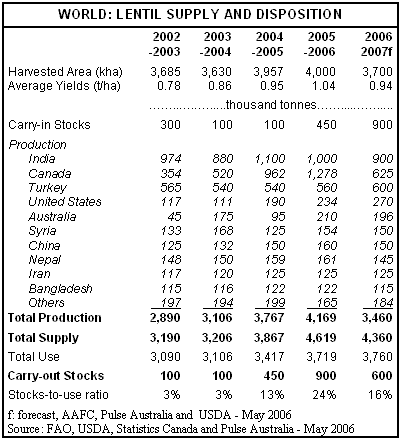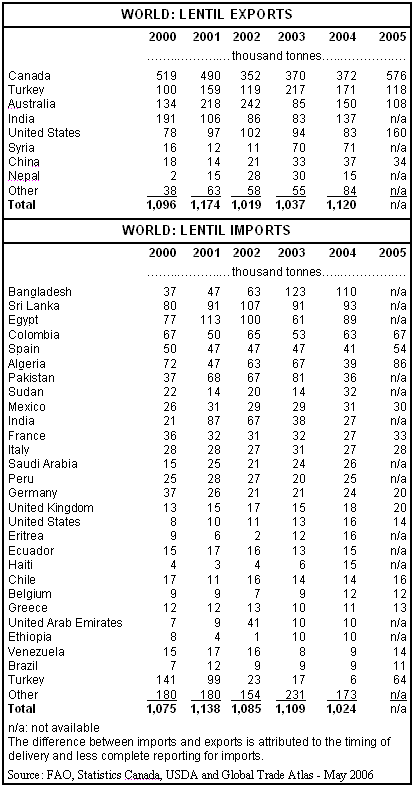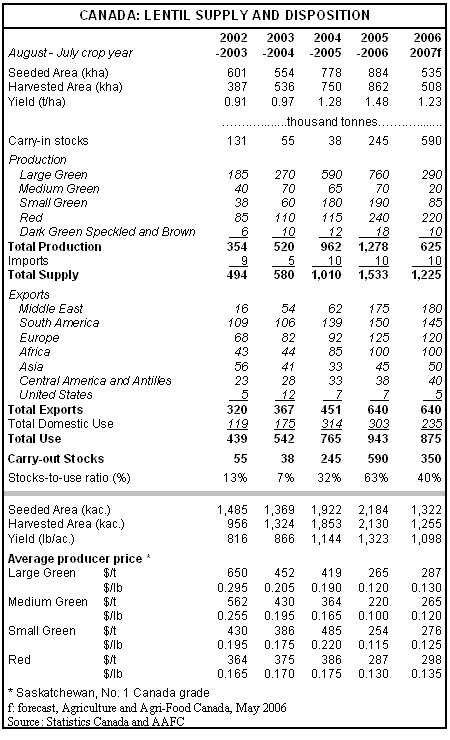Publications: Bi-weekly Bulletin
2006-05-12 | Volume 19 Number 7 | ISSN 1494-1805 | AAFC No. 2081/E
Lentils: Situation and Outlook
Canada is the largest exporter of lentils in the world. It became the largest producer of lentils in 2005-2006, but is expected to return to second place in 2006-2007 because production is forecast to decrease sharply. Exports in 2006-2007 are expected to remain stable, while carry-out stocks decrease sharply. Prices are forecast to increase because of the lower supply. The value of Canadian exports was $233 million (M) in 2004-2005 and is anticipated to reach nearly M$300 in 2005-2006. This issue of the Bi-weekly Bulletin examines the situation and outlook for lentils.
World
Production
Lentils are best adapted to production in the cooler temperate zones of the world or in the winter season in countries, such as India and Australia, which have a warm winter and a hot summer. The seed coat colour of lentils can be clear, green, tan, grey, brown or black. The cotyledon is yellow, red or green. The two main market types are red and green.
World lentil production has been trending upwards during the past 10 years, ranging from 2.76 million tonnes (Mt) in 1997-1998 to 4.17 Mt in 2005-2006. Among the main producers, production has been trending upwards in Canada, the United States (US), Australia and China, but has been relatively stable in India, Turkey, Syria, Iran, Nepal and Bangladesh. In the US, production increased sharply since lentils were first included under the loan program in 2002. Although specific data is not available, an estimated 70% of world lentil production is the red type, 25% green type and 5% brown and other types. Canada and the US produce mainly the green type whereas the rest of the world produces mainly the red type.
Trade
During the past 10 years, world trade has been trending upwards from 0.65 Mt in 1995 to 1.17 Mt in 2001. In 2004, the latest year for which complete data is available, exports were 1.12 Mt. The top five exporting countries (Canada, Turkey, Australia, India and the US) accounted for 82% of world exports. About 60% of the exports were the red type, 35% green and 5% brown and other. Canada share of world exports was 33% in 2004, but increased to about 45% in 2005. Imports were distributed much more widely than exports, with the top 10 importing countries accounting for only 55% of imports.
Canada
Production
Canadian lentil production has increased in response to market signals and contributed to the diversification of crop production in the Prairie Provinces, especially in Saskatchewan. The increase in lentil production has proven to be valuable in crop rotations which help to control weeds, diseases and insects and improve soil texture and fertility. The increased production also contributed to the expansion of the pulse crops handling, marketing and processing industry, which increased employment opportunities in rural areas. During the past 10 years, lentil production has been concentrated in Saskatchewan, which accounted for more than 95% of Canadian production. The balance was produced in Alberta and Manitoba.
Lentils are a cool season crop with a restricted root system which is only moderately resistant to high temperatures and drought. They do not tolerate water logging, flooding or soils with high salinity. In the Prairie Provinces of Canada, lentils are best suited to the Brown and Dark Brown soil zones, but can be grown successfully in the Black soil zone in years without excessive moisture. Lentils work well in a rotation with cereals, such as spring or durum wheat. Nitrogen fertilizer is not recommended because lentils possess the ability to fix nitrogen in nodules on the roots, where it can be used for plant growth. The nitrogen fixed by lentils is also used by other crops in the following years. To maximize the nitrogen fixation ability, lentil seed should be inoculated. Lentils require 90-100 days to mature and should be seeded as soon as the average soil temperature is greater than 5 Celsius.
Canadian production reached a record of 1.28 Mt in 2005-2006. Canada is the main producer of the green type of lentils in the world, accounting for about 75% of world production. However, production of the red type has been increasing and Canada has become a major producer. Canadian production of dark green speckled and brown types is small, accounting for only about 2% of total Canadian lentil production. The Canadian lentil harvest generally occurs during the period from mid-August to early October.
Most of the lentils produced in Canada have a green seed coat and yellow cotyledon. They are normally referred to as large green, medium green and small green, based on the seed size. The large green type includes the Laird, Glamis, Sovereign, Grandora, Plato and Sedley varieties. Their seed size is 60-70 grams/1000 seeds. The medium green type includes the Richlea, Vantage and Meteor varieties, with seed size of 50-55 grams/1000 seeds. The small green type includes the Eston, Viceroy and Milestone varieties, with seed size of about 35 grams/1000 seeds. Canadian red type of lentils have a brown or pale green seed coat with red cotyledons. The red type varieties include Crimson, Redcap, Redberry, Robin, Blaze, Rouleau and Rosetown, with seed size of 30-40 grams/1000 seeds.
Marketing
All of the lentils produced in Canada are sold on the open market to dealers. With the increase in production, the number of dealers across the Prairie provinces who buy, clean and ship lentils to domestic and export customers has increased to about 50. There are several processing plants in Saskatchewan capable of de-hulling and splitting red and green types of lentils for the world market.
Lentils are shipped to ports mainly bagged in containers, although bulk shipments have been increasing with the building of suitable handling facilities. From the ports to overseas customers, they are shipped mainly bagged in containers, although some are also shipped bulk in containers or bulk inside the hold of ships. Most of the Canadian lentils are exported through the ports of Vancouver and Montreal. In addition to whole lentils, Canada also exports split lentils. The export of split lentils has been increasing, as Canadian splitting capacity expanded through the construction of new plants.
Exports
Canada exports about 70% of its production, while most other major producers export a relatively small portion of their production. Canadian lentil exports are dispersed throughout the world. The main importing countries in each region are: Europe (Italy, Germany, Spain, Belgium, France, Greece), Middle East (Turkey, Egypt, United Arab Emirates), Africa (Algeria, Morocco) South America (Colombia, Venezuela, Ecuador, Chile, Brazil, Peru), North America (Mexico, US) and Asia (India, Pakistan).
Although the large green type of lentils is exported all over the world, the main destinations are north-western and southern Europe, Algeria, South America, and Central America. The medium green type is exported mainly to north-western Europe, Spain, Algeria, Morocco and the US. The small green type is exported mainly to Morocco, Greece, Italy, Egypt, and Mexico. The red type is exported mainly to southern Asia, the Middle East and northern Africa. The dark green speckled type is exported mainly to France and the brown type mainly to Spain.
Domestic Use
Canadian domestic use (which includes food, feed, seed, dockage, and waste) accounts for about 30% of production.
Prices
Canadian prices are largely determined in the international markets because Canada exports about 70% of its production. Since Canada produces most of the green type of lentils in the world, while it is a smaller producer of the red type, the level of production in Canada has much more influence on green type prices than on red type prices. The substitution of one type of lentil with another is very limited. Therefore, it is common for wide price spreads to exist between different types of lentils. Since there is no futures market for lentils, prices are negotiated directly between dealers and customers, based on supply and demand factors for each type of lentil, for immediate delivery or for delivery at some future date.
Some lentils are grown under production contracts, which guarantee a price for part of the production, but most are sold on the spot market.
Organisations
The Canadian Grain Commission (CGC) administers quality control standards for lentils. The grades are No.1, 2, 3 and extra 3 Canada other than Red, and No.1, 2, 3 and extra 3 Canada Red. Lentils which do not meet the listed grade standards are graded Sample Canada. The major quality concerns in lentil grading are damage due to heating and peeling, split or broken seed, seed discolouration, as well as foreign material. For further information, or to access the Official Grain Grading Guide, please visit the CGC website: (www.grainscanada.gc.ca)
The Canadian Special Crops Association (CSCA - http://www.specialcrops.mb.ca/) establishes trade rules and serves as a forum for exporters, dealers and brokers involved in the industry of trading Canada pulse and special crops, including lentils. The website includes a section where buyers can submit a request for prices.
Pulse Canada (www.pulsecanada.com) is an industry organization, with the CSCA and provincial pulse growers organizations as members. It is involved in market development, market access, policy issues and coordination of scientific research. The website contains information on pulse crops, markets, and health and nutrition.
Pulse Innovation Project (PIP)
PIP is managed by Pulse Canada and funded mainly by a M$3.2 contribution, over three years starting in 2005, from Agriculture and Agri-Food Canada under the Science and Innovation pillar of the Agricultural Policy Framework. The goal of the PIP is to stimulate innovation in product development by understanding industry needs and targeting research that will boost the incorporation of pulses, including lentils, into food and industrial products. It will support the development and commercialization of products by working with food processors and ingredient manufacturers to ensure that the end results are foods that will be found on grocery store shelves, targeting products that are economic, convenient and enhance nutrition and health. In addition, PIP will explore and support industrial avenues for pulses to ensure the maximum value added opportunities for producers.
Use
On average, about 70% of all lentils are consumed in the countries where they are produced. Total world use has been trending upwards during the past 10 years.
Lentils are generally used for food. They are canned or packaged, whole or split, for retail sale, or processed into flour. They are then used in soups, stews, salads, casseroles, snack food and vegetarian dishes. In southern Asia, split red lentils are used in curries. Lentil flour is added to cereal flour to make breads, cakes and baby foods. Lentils are often used as a meat extender or substitute because of the high protein content and quality. Lentils have a shorter cooking time than other pulses and do not need to be pre-soaked.
Only a relatively small volume of low quality lentils are used for livestock feed, however nutritional analysis indicates that they make an excellent feed.
Healthy Diet
Pulses, including lentils are increasingly being used in health-conscious diets to promote general well-being and reduce the risk of illness. They are low in fat, low in sodium, cholesterol free, high in protein, and are an excellent source of both soluble and insoluble fibre, complex carbohydrates, and vitamins and minerals, especially B vitamins, potassium and phosphorus.
Since lentils are low in fat, low in sodium and are cholesterol free, they are an excellent heart healthy food that may be beneficial to the prevention of cardiovascular disease. Lentils are an inexpensive, high quality source of protein. Studies have shown that whole pulses (including lentils) have demonstrated cholesterol and lipid lowering effects in humans.
Studies have reported the beneficial effects of soluble dietary fibre on cardiovascular disease in humans, especially in lowering both total serum and LDL-cholesterol levels. In addition, clinical research has shown soluble fibre to be beneficial in the management of type-2 diabetes. Insoluble dietary fibre consumption can be beneficial to a healthy colon and has been associated with reducing the risk of colon cancer. Diets high in fibre have demonstrated beneficial effects on weight loss because they deliver more bulk and less energy.
Lentils are an excellent source of the B vitamin folate which is an essential nutrient. In addition, folate consumption during pregnancy has been shown to reduce the risk of neural tube defects.
Flour made from lentils is gluten free and is a very nutritious option for people with celiac disease.
Outlook: 2006-2007
World
World production is forecast to decrease by 17% from 2005-2006, to 3.46 Mt, mainly due to lower production in Canada. Canada share of world production is expected to decrease to 18% from 31% in 2005-2006. World supply is forecast to decrease by only 6% to 4.36 Mt, as higher carry-in stocks offset most of the decrease in production. Canada share of world supply is expected to decrease to 28% from 33% in 2005-2006. Total world use is forecast to increase, while carry-out stocks fall sharply.
Canada
Area seeded to lentils in Canada is expected to decrease by 40%, according to Statistics Canada seeding intentions survey. The sharp decrease in expected seeded area is due to historically low prices and high carry-in stocks for green lentils. Since the survey was conducted during March 17-31, 2006, the actual seeded area may differ from the intentions due to changes in the market outlook and expected prices, and producer reaction to the seeding intentions report. Assuming normal precipitation for the growing and harvest periods, and the resulting normal abandonment and trend yields, production is expected to decrease by 51% from 2005-2006 to 625,000 tonnes. In 2005-2006, average yields were significantly above trend. The main factor to watch is precipitation during the growing and harvest periods. At the start of seeding, soil moisture reserves in the lentil growing areas were generally average to above average. Production is expected to decrease for all types, with a moderate decrease for red lentils, and a large decrease for green lentils.
Supply is forecast to decrease by only 20% to 1.23 Mt, due to higher carry-in stocks. Exports are expected to be similar to 2005-2006. Carry-out stocks are forecast to decrease sharply to 0.35 Mt, with the stocks-to-use ratio decreasing to 40%. Average producer prices are forecast to increase from 2005-2006 because of the lower world and Canadian supply. However, prices could be very volatile, especially for the green types, if there are any production problems.
by
While the Market Analysis Division assumes responsibility for all information contained in this bulletin, we wish to gratefully acknowledge input from the following: Pulse Canada; Saskatchewan Agriculture and Food; Saskatchewan Pulse Growers, Market and Industry Services Branch (AAFC)
|
|
||
| Date Modified: 2006-12-08 |
|
|
|
[ Français | Contact Us | Help | Search | Canada Site ] [ AAFC Online | Links | Newsroom | What's New | Site Index ] |
||



